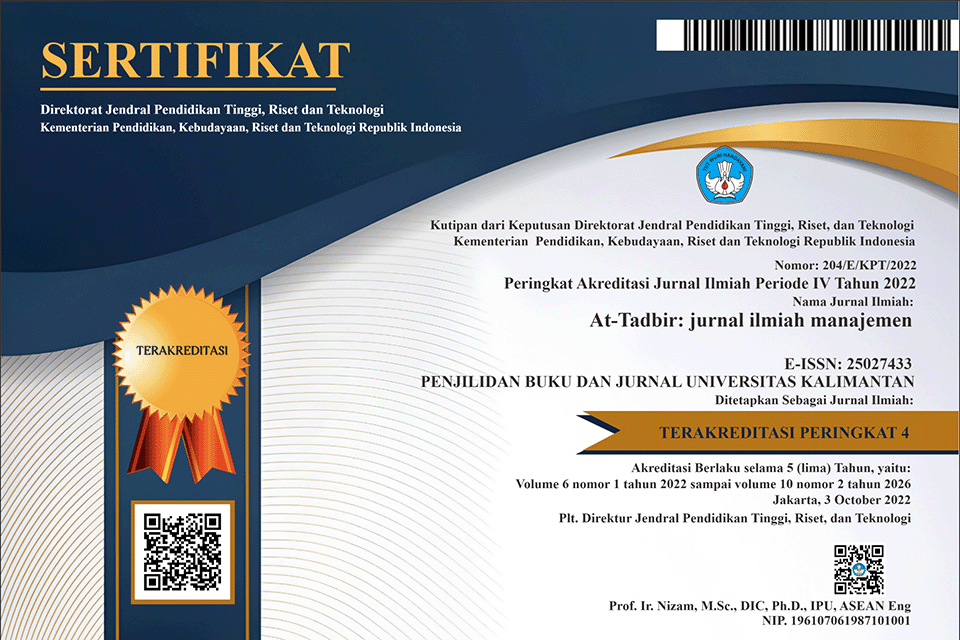PENGARUH PENGETAHUAN NASABAH DAN KUALITAS LAYANAN TERHADAP MINAT INDIVIDU PENGGUNA INTERNET BANKING BANJARMASIN
(1) Fakultas Ekonomi Magister Manajemen
(2)
(3)
(*) Corresponding Author
Abstract
PT. Natra Raya company is licensed by Catterpillar Inc. to produce the Caterpillar heavy equipment. The challenge in seizing market share requires companies to provide competitive prices. The increase in raw material prices, employee wages, transportation costs, charges the company more. The use of Balanced Scorecard on performance measurement helps companies create a comprehensive performance measurement system to measure company performance to be more efficient. This study uses two methods of analysis. The process of making a balanced scorecard design uses quantitative analysis while qualitative used to calculate process, measuring Key performance Indicators weight and performance range. The results of the survey with the balanced scorecard approach show that the performance of PT. Natra Raya is good with an index number of 103.4% (green code). The balanced scorecard method shows that the performance of PT. Natra Raya cannot only be measured in a limited way. This method can show that there are parts of the indicator that need special attention, namely KPIs with poor performance evaluation results shown in the sub-KPI of employee capability due to the KPI's focus on resources getting a bad score. The sub-KPI, when completing the project, gets a poor performance evaluation result, but outside of the three sub-KPIs, the results of PT. Natra Raya is good and very good.
Full Text:
90-97 (Bahasa Indonesia)References
Ambarita, R. (27 September 2012). Anggap Karyawan Aset, Kunci Sukses Perusahaan. http://www.kabarbisnis.com/read/2833544
Dessler, G. (2009). Manajemen Sumber Daya Manusia. Jakarta : Index.
Dessler, Gary(2015). Human Resources Management (Manajemen Sumber Daya Manusia), Ed. 14. Edisi Bahasa Indonesia. Jakarta: Indeks.
George, J.M. & Jones, G.R. (2005). Understanding And Managing organizational behavior (4th ed.). New Jersey: Upper Saddle River Whetten, D.A., and Cameron, K.S. (2011). Developing management skills (8th ed.). New Jersey: Upper Saddle River.
Hasibuan, Malayu S.P. 2008. Manajemen Sumber Daya Manusia. Jakarta : Bumi Aksara.
Hasibuan(2014). Manajemen Sumber Daya Manusia. Bandung: Bumi Aksara.
Imam Ghozali, Aplikasi Analisis, hlm. 147.
Mangkunegara, A.P. (2005). Evaluasi Kinerja Sumber Daya Manusia. Cetakan I. Bandung: PT Refika Aditama. --------------------------. (2006). Manajemen Sumber DayaManusia. Remaja Rosdakarya. Bandung.
Mangkunegara, A.P. (2014). Manajemen Sumber Daya Manusia Perusahaan. Jakarta: PT. Rajagrafindo Persada.
Marwansyah. 2014. Manajemen Sumber Daya Manusia. Bandung : Alfabeta.
Rivai, Veithzal danSagala,Ella Jauvani (2014), Manajemen Sumber Daya Manusia Untuk Perusahaan, Ed. 3. Jakarta: PTRajawali press.
Raymond, A., Noe., John, R., Hollenbeck., Barry, G. &Patrick, M.W. (2008). Human Resources Management : Gaining A Competitive Advantage, 6th Edition, McGrawHill/Irwin.
Sedarmayanti. 2013. Manajemen Sumber Daya Manusia. Bandung : PT Refika Aditama.
Sunyoto, D. (2012). Teori, Kuisioner Dan Analisis Data Sumber Daya Manusia. Yogyakarta: CAPS.
Sutrisno, Edy. 2009. Manajemen Sumber Daya Manusia. Kencana Prenada Media Grup. Jakarta.
Wijonarko. (27 September 2012). Anggap Karyawan Aset, Kunci Sukses Perusahaan. http://www.kabarbisnis.com/read/2833544
DOI: http://dx.doi.org/10.31602/atd.v3i2.1873
Refbacks
- There are currently no refbacks.
Copyright (c) 2019 Sri Bulkia, Ana Sofia Herawati, Nurul Hasanah
---------------------------------------------------------------------------------------------------------------------
At-Tadbir: Jurnal Ilmiah Manajemen is licensed under Creative Commons Attribution-Share A like 4.0 International License




